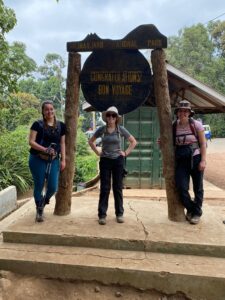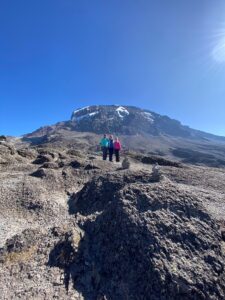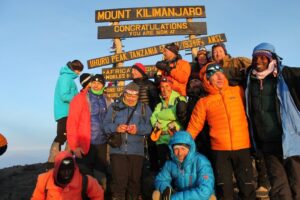
Small Groups.

Secured
Payments

Local Guides.

Easy Payments
About Kilimanjaro Mountain.
Conquer the majestic Kilimanjaro! Embark on a thrilling expedition to Africa’s highest peak, where breathtaking views and exhilarating challenges await.
Our experienced guides will lead you through the awe-inspiring landscapes, ensuring your safety and creating unforgettable memories. Prepare for the adventure of a lifetime on Kilimanjaro!
Start With us?
Altitude Sickness on Kilimanjaro
Climb Mount Kilimanjaro .
It is not the lack of fitness that prevents people from reaching the summit of Kilimanjaro, it’s altitude sickness!
If you reach the top of Kilimanjaro depends more than anything else on how you cope with the altitude.
And how you cope with the altitude is not a matter of random luck! There are many things you can do to avoid the symptoms of acute mountain sickness when climbing Mount Kilimanjaro.
When you research altitude sickness you often read that it affects people randomly, regardless of age or fitness level.
You may also come across data giving percentage numbers for how many people develop dangerous altitude sickness symptoms at certain heights, and the numbers may look scary.
You have to understand how researchers get these numbers.
Scientific studies of altitude sickness are done by taking a number of people from sea level to a certain altitude and then measuring how they react. Yes, they react randomly, and yes, if you take someone from sea level directly to 3500 meters then there is a good chance that they won’t feel too sprightly at the end of the day.
The difference during a Kilimanjaro climb is that hopefully you will NOT take yourself from sea level to 3500 meters that fast.
The key to preventing altitude sickness on Kilimanjaro is taking your time. Altitude sickness is not just a result of the absolute height you are at, it also depends how fast you got there!
Even though our susceptibility to extreme altitude varies and is impossible to predict, we do know that the body adjusts to it eventually. There are many things you can do before and during a Kilimanjaro climb that will lessen the risk of altitude sickness symptoms.
What is altitude sickness?
Altitude sickness is a range of symptoms that can occur when someone ascends to a high altitude too rapidly, without sufficient acclimatization.
The body can adjust to the reduced air pressure at higher altitude, but only at a rate of about 300m (1000 ft) altitude gain per day. If you ascend faster, and everybody climbing Kilimanjaro will, then you may develop altitude sickness.
There are three main forms of altitude sickness:
- AMS (Acute Mountain Sickness) is very common when climbing Kilimanjaro.
- HAPE (High Altitude Pulmonary Edema) is a fluid build up in the lungs.
- HACE (High Altitude Cerebral Edema) is fluid build up in the brain.
Both HAPE and HACE are potentially fatal but are thankfully extremely rare during a well planned Kilimanjaro climb.
What exactly causes the individual symptoms of altitude sickness is still not fully understood.
There is also a range of other symptoms you are likely to experience during a Kilimanjaro climb due to the altitude. They are considered normal and shouldn’t worry you:
- You breathe faster,
- You are out of breath sooner,
- You may experience periodic breathing at night (where you stop breathing for up to 15 seconds, and then breathe very fast to make up for it, scary but harmless),
- You may wake up frequently at night,
- You need to urinate a lot more often.
None of those symptoms are altitude sickness.
What are the symptoms of altitude sickness?
The symptoms of AMS are headaches, loss of appetite, nausea, vomiting, sleeplessness, fatigue, dizziness. Everybody can expect to experience at least some of these symptoms in a mild form.
The most obvious symptoms for HAPE are extreme breathlessness, even at rest; rattling breath, coughing with pink froth and blue lips or finger nails.
HACE becomes apparent as a lack of coordination, inability to walk in a straight line, confusion and irrational behaviour (to the point of not acknowledging the symptoms).
How dangerous is altitude sickness?
The symptoms of acute mountain sickness as described above are self limiting and not dangerous. In fact, your guides may tell you during the briefing not to worry, that it is totally normal to be throwing up repeatedly during that last final push top the summit. Nice…
However, if you do experience symptoms, your guides should also keep monitoring you, because AMS can progress to one of the more severe forms of altitude sickness.
HAPE and HACE are potentially fatal! Make sure that you always remain in contact with your guides and let them know exactly how you are feeling. Also keep an eye on your climbing partners, since people suffering from these severe conditions may not be able to correctly assess their own condition.
Anybody experiencing symptoms that could indicate HAPE or HACE needs to descend IMMEDIATELY or they will die.
But please don’t panic now. As I said above, these conditions are extremely rare, provided you act sensibly when on the mountain.
What I mean by sensibly is explained on the page about preventing altitude sickness on Kilimanjaro.
Who gets altitude sickness?
Anybody can get altitude sickness. There is no way to predict how your body will react if exposed to high altitude without proper acclimatization.
Susceptibility to altitude sickness is random. Fitness is no protection. People who are extremely fit and exercise a lot get it just a easily as couch potatoes.
Men appear to be more susceptible than women, especially young and fit men. (Competitiveness and the desire to show off plays a part in this. Men will often ascend faster. Too fast.)
Older people seem to be less susceptible. (Older people will ascend more slowly, and nothing protects you better from altitude sickness than ascending slowly.)
When do you get altitude sickness?
Highly susceptible people can experience symptoms from 2500 m (7000 ft) onwards, in rare cases even below that. The chance of developing AMS increases with the height but the rate of altitude gain is even more important.
Mt. Kilimanjaro is 5895 m (19340 ft) high. Pretty much everybody on a Kilimanjaro climb will experience some symptoms of altitude sickness during that last push to the summit.
There are other factors that increase the likelihood of altitude sickness, apart from the absolute height itself:
- Rate at which a height is achieved (the faster you ascend the bigger the risk of developing symptoms, this factor is more important than the absolute height itself!)
- Time spent at height (symptoms start appearing within 6-10 hours though they can be delayed)
- Physical exertion
- Dehydration
Symptoms of acute mountain sickness typically take one or two days to disappear. If you keep ascending they may not go away. For most people the symptoms come and go during the day, disappear overnight, only to come back the next day as the climb continues.
AMS can be very unpleasant, but with the right preparation and at a sensible pace, most people can climb to at least the last camp below the crater rim (around 4700m). It’s that last push to the summit where AMS becomes the make it or break it issue.
Our Happy Clients!
Our Tanzania trip was fabulous. Spotting the Tree-climbing lions and Black Rhino was unforgettable. Thanks for fulfilling our dreams. We’ll be back soon!

Clara Smith
Thank you, Maasai Land Wonders Team, for your exceptional care during my 3 Months Volunteering program. A thousand thanks for an unforgettable experience.

Shelly Barns
Thank you, Edwin and your team, for an amazing 7-day trip. Your personal care and dedication made it unforgettable. 1000 thanks!

Jacob Luke
Contact us, We're at your Service.








Trusted by:

